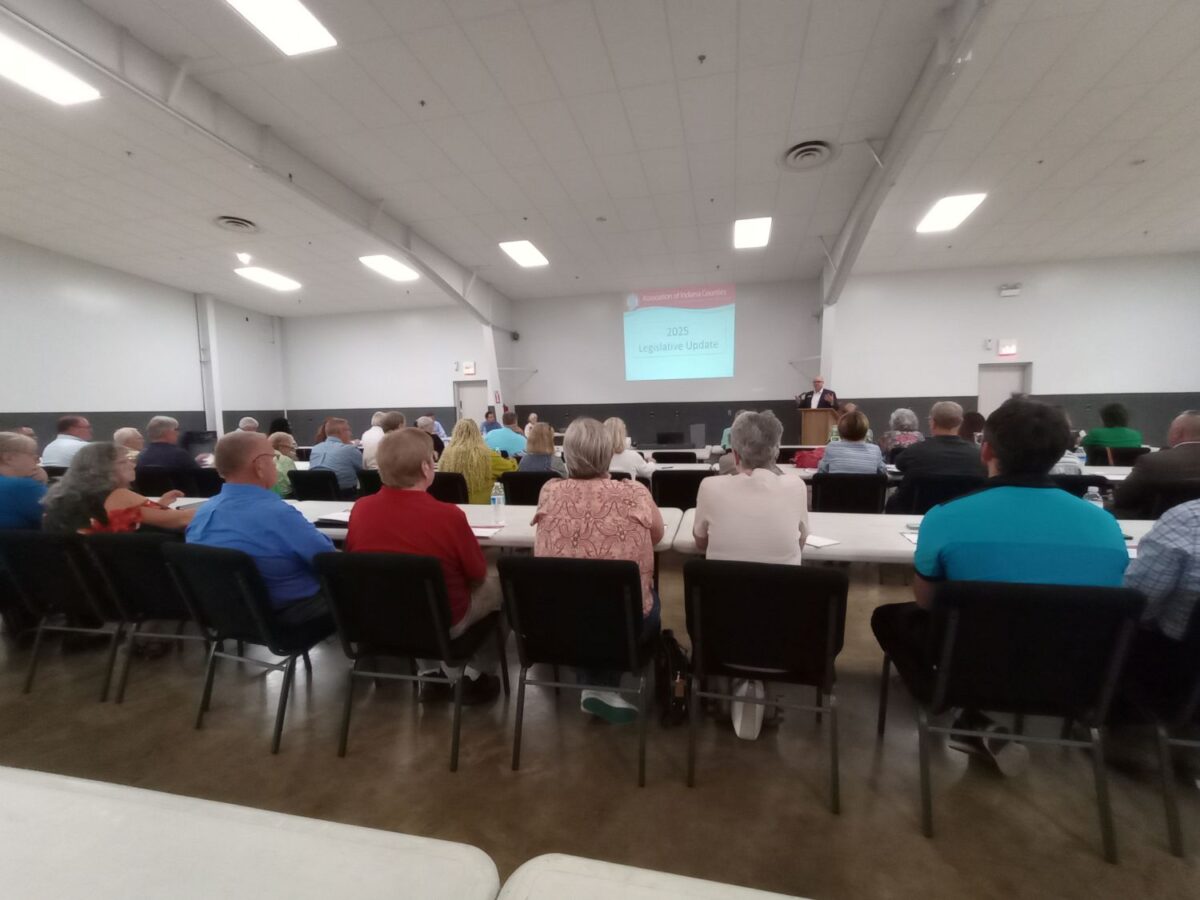Indiana’s legislature is forcing the question of how much government is too much government on communities across the state, and Wayne County residents could soon pay new local income taxes as a result.
The Republican-controlled Indiana General Assembly implemented property tax reform this year, limiting how much property tax revenue cities and counties can expect to have to pay for government infrastructure and services. According to Katrina Hall of the Indiana Farm Bureau, lawmakers provided local governments with more predictable revenue tools to offset that loss, and one of those tools is a local income tax — up to a 2.9% rate for an individual — that could be imposed beginning with 2028 budgets.
Hall, the Farm Bureau’s senior director for policy strategy and advocacy, told more than 80 representatives from Wayne County taxing units that local governments face the responsibility of discussing that central question of how large a given government unit should be.
Hall and three other policy experts spoke about impacts of new legislation Aug. 7 during a session sponsored by the Wayne County Area Chamber of Commerce in First Bank Kuhlman Center. The “Navigating the Shifting Landscape of Taxes and Revenue” program explained the legislative changes for representatives from county government, Richmond, towns, townships, schools and libraries.
“Our hope is that when you make decisions, you are able to make educated decisions,” said Melissa Vance, the chamber’s president and CEO, to the attendees.
Indiana’s legislature enacted Senate Bill 1, implementing property tax reform and shifting the local revenue burden. Ryan Hoff, the director of government relations and general counsel for the Association of Indiana Counties, said there are short-term impacts; however, the true impacts won’t be known for five to 10 years. The legislature will adjust and update the policies.
“As a package, this is probably the biggest change to local government finance in Indiana in the past 50-plus years,” Hoff said, referring to Gov. Otis Bowen’s property tax controls taking effect in 1973.
The legislation phases out the $48,000 Homestead deduction through 2031, while providing a 10% Homestead tax credit that’s capped at $300. Deductions for age 65 and older ($150) and disabled property owners ($125) will become tax credits. Also by 2031, homeowners will only pay their property tax rate on one-third of their properties’ assessed values.
The agricultural base rate for property tax charges will be reduced, and agriculture and apartments will have property tax rates applied to two-thirds of their assessed value. For businesses, the exemption for personal property tax payments rises from $80,000 to $2 million, which will exempt about 90% of businesses. New business equipment also will no longer have a 30% valuation floor for depreciation.
A chart presented during the program shows the estimated decrease from the previously expected levy funding for each Wayne County taxing entity. The decreases for 2026 vary from 3.9% for Harrison Township to 9.2% for Greens Fork. Wayne County government’s decrease is expected to be 6.2%, Richmond’s 6.3%, Centerville’s 6.2%, Cambridge City’s 6.7%, Hagerstown’s 7.7% and Fountain City’s 7.4%.
The legislature made the county fiscal body — Wayne County Council — the adopting body for all county-wide LIT rates, although Richmond, as the only municipality with a population greater than 3,500, also can enact a municipal LIT. The available county LITs, which are optional, are:
- Up to a 1.2% rate for county general revenue that would be paid county-wide.
- Up to a 0.4% rate for fire protection and emergency medical services that would be distributed to providers.
- Up to a 0.2% rate for nonmunicipal civil taxing units, such as townships and libraries, but it must include all units within the county.
- Up to a 1.2% rate for distribution to municipalities not eligible to adopt a LIT, or if the county has maxed out its 1.2% rate, the county can retain up to 75% of this rate for its own uses.
- Up to a 0.3% rate to offset the county property tax rate.
Hoff said the maximum a resident can pay is 2.9%, and LIT rates must be annually readopted after 2030.
Wayne County and Richmond also have the option of enacting local option highway user taxes on vehicles. Wayne County is conducting public hearings about adopting the so-called wheel tax that raises money only for highway and bridge work, plus makes the county eligible for state lane-mile money distributions, which will begin in January 2027.
According to Hoff, governments will need to discuss if services can continue being funded with the available revenues. It also presents the question of whether the smallest among towns, townships, schools and libraries will survive.
Share your view
How can local residents participate in the discussion and help shape the outcome?
Those interested in contacting county council members can email wcc@co.wayne.in.us or call 765-973-9237 to reach the body’s seven elected members. Their individual contact information is also available online at co.wayne.in.us/council. The council meets the first Wednesday of every month at 8 a.m. in the county’s administration building, and the public may attend.
While it might be too late to change the property tax reform measures passed this year, residents can also contact their state legislators to share feedback and ideas for future legislative sessions. You can find your legislators at iga.in.gov/information/find-legislators or by calling the statehouse at 317-233-5293.
The Western Wayne News periodically publishes letters to the editor about topics of local interest that are 300 words or less, emailed to contact@westernwaynenews.com or mailed to 26 W. Church St., Cambridge City, IN 47327. See additional requirements and guidelines at WesternWayneNews.com/submissions/.
A version of this article appeared in the August 13 2025 print edition of the Western Wayne News.

